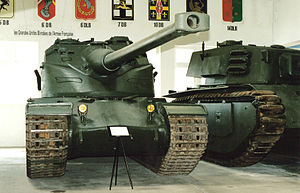AMX 50
| AMX 50 | |
|---|---|

The AMX 50 cast hull with the Tourelle D, at Saumur
|
|
| Type | Heavy tank |
| Place of origin | France |
| Specifications | |
| Weight | 57.8 metric tonnes |
| Length | 7.35 m (24 ft 1 in) |
| Width | 3.4 m (11 ft 2 in) |
| Height | 3.35 m (11 ft 0 in) |
| Crew | 4 |
|
|
|
| Armor | 80-120 mm |
|
Main
armament |
120 mm |
|
Secondary
armament |
2 x 7.5 mm machine guns |
| Engine | Maybach HL 295 12VC 850 hp |
| Power/weight | 15 hp/ton |
| Suspension | torsion bar |
|
Operational
range |
250 km |
| Speed | 51 km/h (32 mph) |
The AMX 50 (official designation) or AMX-50 was a French heavy tank designed in the immediate post Second World War period. It was proposed as, in succession, the French medium, heavy, and main battle tank and incorporated many advanced features. However, it was to suffer cancellation in the late 1950s due to unfavourable economic and political circumstances combined with delays in development.
After the war the French Army possessed no modern tanks with a heavy armament. The ARL 44 was being developed, but this vehicle, though to be armed with a powerful 90 mm gun, could hardly be called modern, as its suspension system was obsolete. Therefore already in March 1945 the French industry had been invited to design a more satisfactory vehicle. The same year the AMX company (Atelier de Construction d'Issy-les-Moulineaux) presented its projet 141, a project to build the so-called M 4 prototype, armed with a 90 mm Schneider gun.
The M 4 closely resembled the German Tiger II in general form, though the turret was to be made of welded sections; but to limit the weight to a desired thirty metric tonnes the proportions were rather smaller and the armour had a maximum of just thirty millimetres. Like the later German tanks of the war it had, in this case eight, overlapping road wheels. Part of the project was to study whether a modern torsion bar suspension should be used or the height lowered by ten centimetres through a fitting of leaf or coil springs.
Two prototypes of the M 4 were ordered. The Army soon indicated that a protection level offered by thirty millimetres armour thickness was unacceptably low. In response armour was increased. To save weight it was decided to install a novel oscillating turret, designed by the Compagnie des forges et aciéries de la marine et d'Homécourt (FAMH). Nevertheless, when the first prototype, now named the AMX 50 after its intended weight class, was delivered in 1949, it weighed 53.7 metric tonnes. In the winter of 1950 instead of the 90 mm, a 100 mm gun was fitted, designed by the Arsenal de Tarbes. The second prototype with a slightly different turret, but also with a 100 mm gun, was ready soon after. The prototypes had a length, with gun, of 10.43, a width of 3.40 and a height of 3.41 metres. It was intended to fit a 1200 hp engine to attain a speed much superior to all existing medium tank types. The Maybach HL 295 (a redesigned German gas engine in 1945 captured at Friedrichshafen by Engineer-General Joseph Molinié) and a Saurer diesel engine were tested. Both failed to deliver the required output and maximum speed was in fact no higher than 51 km/h. The prototypes were tested between 1950 and 1952.
...
Wikipedia
